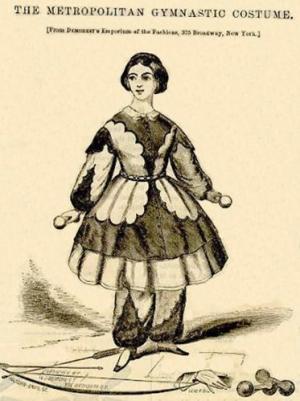Thinking Historically: The Evolution of Women’s Athletic Wear

This lesson will consist of several activities that will develop students historical thinking skills. Through the use of pictures and descriptions of women’s athletic wear from the mid-19th century to the mid-20th century, students will practice several historical thinking skills including change over time, contextualization, comparing and contrasting, and through a final writing prompt developing an argument.
60 to 90 minutes
Students will be able to analyze primary source to demonstrate historical thinking skills (including change over time, contextualization, comparing and contrasting, and argumentation).
This should be completed before the lesson and can be in class or as homework:
https://www.smithsonianmag.com/science-nature/rise-modern-sportswoman-180960174/
- Evolution of Women’s Athletic Wear Guided Worksheet
- Primary source document
- A method to print or share with students
Activity
This lesson provides a lot of flexibility in which components teachers would like to incorporate into their classrooms. Teachers can complete the entire lesson or specifically select historical thinking skills that they wish to have their students’ practice.
Step 1
Student should spend ten to fifteen minutes examining the documents focusing on what they see in the images or notice about the written statements. Have students take notes on any observations they might have about what women were expected to wear for athletic events.
Step 2
Teachers should direct students to fill out the change over time question. Give students about five or ten minutes and then discuss those as a class. Call for volunteers and discuss the students’ ideas on how female athletic wear changed over time.
Change over Time Question:
-
Looking at the sources of women’s sportswear, from the mid-19th century to the 1930s, how have the uniforms that women wore changed over time? Has anything stayed the same?
Step 3
Teachers should direct students to fill out the compare and contrast questions. Give students about ten or fifteen minutes and then discuss those as a class. Call for volunteers and discuss the students’ ideas on the similarities and differences that they witnessed in the uniforms and athletic wear.
Compare and Contrast Questions:
-
Looking at each set of sources, list three ways in which they are similar and three ways in which they are different.
-
How does the sportswear in Source 1 differ from Source 6?
-
How was the sportswear different from Source 1 to Source 2?
-
How did the field hockey uniform from Source 3 look different than Source 6?
-
What set of sportswear would be the easiest to play a sport in? Support your answer.
Step 4
Teachers should direct students to fill out the contextualization questions. Give students about five or ten minutes and then discuss those as a class. Call for volunteers and discuss the students’ ideas on how the larger historical context surrounding American society during these times might have impacted women’s athletic wear.
Contextualization Questions:
-
Using your background knowledge of women’s position in society and societal norms during the time period, do you believe that women’s sportswear reflected the feelings of most in society? If so, how?
Step 5
Teachers should direct students to formulate a thesis statement. Give students about ten or fifteen minutes and then discuss those as a class. Teachers can choose to share these thesis statements in various ways including a call for volunteers, but they could also create a collage of statements on the white board or in a central (shared) document that is projected so that the class can view their progress. After the students have shared their thoughts, discuss the central historical question about whether sports became an avenue to female empowerment or not.
Argumentation Prompt:
-
In many ways, women participating in sports served as a way to break free from the constraints of society that women faced day-in and day-out. Develop a thesis statement in which you argue whether or not this liberation is reflected in the athletic wear women wore.
Standards:
D2.His.2.9-12. Analyze change and continuity in historical eras.
D2.His.12.9-12. Use questions generated about multiple historical sources to pursue further inquiry and investigate additional sources.
D3.1.9-12. Gather relevant information from multiple sources representing a wide range of views while using the origin, authority, structure, context, and corroborative value of the sources to guide the selection.
D4.1.9-12. Construct arguments using precise and knowledgeable claims, with evidence from multiple sources, while acknowledging counterclaims and evidentiary weaknesses.
D4.2.9-12. Construct explanations using sound reasoning, correct sequence (linear or non-linear), examples, and details with significant and pertinent information and data, while acknowledging the strengths and weaknesses of the explanation given its purpose (e.g., cause and effect, chronological, procedural, technical).
